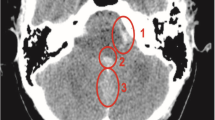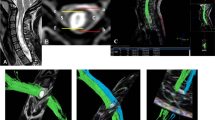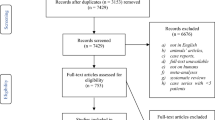Abstract
Study design: Review and analysis of seven cases of syringomyelia treated surgically.
Objective: To demonstrate the beneficial role of decompressive surgery for the altered cerebrospinal fluid (CSF) flow dynamics in syringomyelia not associated with Chiari I malformation. A comparison between the pre- and post-operative syrinx size and CSF flow in the subarachnoid space was made using cine-mode magnetic resonance imaging (cine-MRI) and then correlated with clinical improvement.
Setting: University Hospital, Seoul, Korea.
Methods: Conventional spinal MRI and cine-MRI were performed in the region of CSF flow obstruction preoperatively in seven patients with syringomyelia not associated with Chiari I malformation. The group consisted of one case of syrinx with post-traumatic compression fracture, one case of post-traumatic arachnoiditis, two cases of holocord syrinx associated with hydrocephalus without Chiari malformation, one case of syrinx with post-traumatic pseudomeningeal cyst, one case of post-laminectomy kyphosis-associated syringomyelia and one case of post-tuberculous arachnoiditis syringomyelia. Based on the preoperative cine-MRI, the types of surgery appropriate to correct the CSF flow obstruction were chosen: decompressive laminectomy-adhesiolysis and augmentation duraplasty in arachnoiditis cases, ventriculoperitoneal shunt for hydrocephalus, cyst extirpation in pseudomeningeal cyst and both anterior and posterior decompression-fusion in the case of post-laminectomy kyphosis. A syrinx-draining shunt operation was performed in three cases; where the syringomyelia was associated with post-traumatic compression fracture refractory to a previous decompression, where hydrocephalus was present in which the decompression by ventriculoperitoneal shunt was insufficient and where post-traumatic arachnoiditis was present in which the decompression was impossible due to diffuse adhesion. Change in syrinx size was evaluated with post-operative MRI in all seven cases and restoration of flow dynamics was evaluated with cine-MRI in three of the cases, two patients with clinical improvement and one patient with no change of clinical status, respectively.
Results: Four out of seven patients showed symptomatic improvement after each decompressive operation. In the remaining three cases, reconstruction of the spinal subarachnoid space was not possible due to diffuse adhesion or was not the main problem as in the patient with syrinx associated with hydrocephalus who had to undergo a shunt operation. One of these three patients showed clinical improvement after undergoing syringosubarachnoid shunt. A decrease of syrinx size was observed in only two out of the five patients who showed clinical improvement after treatment. Of these five patients, two patients underwent post-operative cine-MRI and the restoration of normal CSF flow dynamics was noted in both patients. Of the remaining two patients, one underwent post-operative cine-MRI and there was no change in the CSF flow dynamics evident.
Conclusion: These results suggest that the restoration of CSF flow dynamics between the syrinx and the subarachnoid space by decompressive operation is more effective than simple drainage of the syrinx cavity itself in the treatment of syringomyelia without Chiari malformation.
Similar content being viewed by others
Log in or create a free account to read this content
Gain free access to this article, as well as selected content from this journal and more on nature.com
or
References
Heiss JD et al. Elucidating the pathophysiology of syringomyelia J Neurosurg 1999 91: 553–562
Armonda RA, Citrin CM, Foley KT, Ellenbogen RG . Quantitative cine-mode magnetic resonance imaging of Chiari I malformations: an analysis of cerebrospinal fluid dynamics Neurosurgery 1994 35: 214–223
Milhorat TH et al. Surgical treatment of syringomyelia based on magnetic resonance imaging criteria Neurosurgery 1992 31: 231–244
Goel A, Desai K . Surgery for syringomyelia: an analysis based on 163 surgical cases Acta Neurochi (Wien) 2000 142: 293–301
Klekamp J, Batzdorf U, Samii M, Bothe HW . Treatment of syringomyelia associated with arachnoid scarring caused by arachnoiditis or trauma J Neurosurg 1997 86: 223–240
Sougoros S, Williams B . Management and outcome of postraumatic syringomyelia J Neurosurg 1996 85: 197–205
Sgouros S, Williams B . A critical appraisal of drainage in syringomyelia J Neurosurg 1995 82: 1–10
Iwasaki Y, Hida K, Koyanagi I, Abe H . Reevaluation of syringosubarachnoid shunt for syringomyelia with Chiari malformation Neurosurgery 2000 46: 407–412
Acknowledgements
This work was supported in part by a grant from the Seoul National University Hospital Research Fund.
Author information
Authors and Affiliations
Rights and permissions
About this article
Cite this article
Lee, JH., Chung, CK. & Kim, H. Decompression of the spinal subarachnoid space as a solution for syringomyelia without Chiari malformation. Spinal Cord 40, 501–506 (2002). https://doi.org/10.1038/sj.sc.3101322
Published:
Issue date:
DOI: https://doi.org/10.1038/sj.sc.3101322
Keywords
This article is cited by
-
Treatment of posttraumatic syringomyelia: evidence from a systematic review
Acta Neurochirurgica (2020)
-
Post-traumatic syringomyelia with holocord involvement: a case report
Spinal Cord Series and Cases (2017)
-
Surgical management of syringomyelia unrelated to Chiari malformation or spinal cord injury
European Spine Journal (2016)
-
New surgical approach for late complications from spinal cord injury
BMC Surgery (2006)
-
Holocord myelopathy with thoracic stenosis: case report and hypothesis
Spinal Cord (2003)



